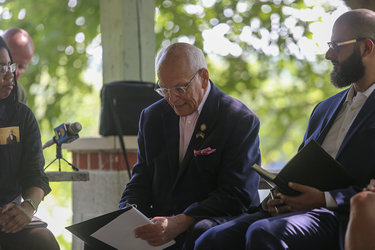Despite federal cuts and chaos, leaders of historic sites ‘keep on keeping on’
Stories rooted in the lands and waterways of his district are under threat, said Congressman Paul Tonko on July 30.
He met on Peebles Island, at the confluence of the Mohawk and Hudson rivers near the Erie Canal locks, with a group of 10 people who care deeply about history. Peebles Island is home to the state’s bureaus for historic sites and historic preservation.
Since President Donald Trump began his second term, Tonko has held a series of roundtable discussions — one with library leaders, another with leaders of local food banks — focusing on the effects of cuts in federal funds have had on their work.
“Right now,” said Tonko of the stories that museums and historic sites have told, “these stories are under threat. And I can’t believe in an open democracy that we would have to even echo that thought. The administration is trying to drag us backward, erasing voices, rewriting history.”
The Institute of Museum and Library Services — both its funding and its workforce — is “at risk,” Tonko said. Trump, in a March 14 executive order, listed the IMLS among agencies that he had “determined are unnecessary.”
Tonko also lamented “a calculated campaign of historical erasure” citing websites that have been scrubbed of contributions made by minorities.
“At the Stonewall National Monument in New York City, references to trans and bisexual people were simply removed,” said Tonko.
He went on “Our parks, our museums, our libraries, our cultural sites are places where learning happens. They are spaces of reckoning and restoration. They root us in a sense of place and remind us that the work of building a more perfect union isn’t just found in textbooks or in legislation. It lives in the very landscapes and stories that we preserve and share.”
Tonko urged the group whose members formed a semi-circle beside him, “Let’s build each other up … We’re going to stand for and expose what’s going on.”
Education
Mary Liz Stewart, who with her husband, Paul, founded and runs the Underground Railroad Educational Center in Albany, said that every summer they host a Young Abolitionist Leadership Institute, educating Black teens.
The center is housed in the restored 19th-Century Albany home of Black abolitionists Stephen and Harriet Myers.
The Young Abolitionists said that “they are learning African-American history they have not heard about in school,” Stewart reported.
This both pleased and dismayed her. She was pleased that they were learning but dismayed that what they were learning wasn’t taught in public schools.
“When they leave us, where else will they be able to access information that will increase their knowledge base about Black history?” asked Stewart.
Lacey Wilson, who manages a program in museum studies for Black teens at the center, spoke of the importance of “giving them the opportunity to show the story that they value.”
During July, her students did research at the University at Albany archives and put on an exhibit about what they had learned.
“Right now,” Wilson said, “there are a lot of conversations in Albany about youth activities outside of school and dangers and crimes, but we had a great opportunity to really listen to the youth, what they’re looking at in terms of recent history and what they want to see differently.”
The center had received an email in April saying the IMLS funding for Wilson’s program was cancelled but the court said otherwise, Wilson reported.
Wilson’s students learned of demands made in the late 1960s by the local chapter of the NAACP, and by the SUNY Black Student Alliance and Albany City public school students. Then Wilson’s students “created their own demands for what they’d like to see from the city of Albany.”
“Some things were just straight-up similar,” Wilson said. One demand that interested her was more training for hall monitors because that would be a better solution than jailing.
“The thing that repeated across all of these were more Black teachers and more Black guidance counselors,” said Wilson. “That’s something we very much still see. And I think, until they had the language that people were asking about this before they were born, they wouldn’t have known that this is something they could try to ask.”
Michael Diana, the education director at the Schenectady County Historical Society, spoke of the summer enrichment program where elementary school students learn hands-on lessons at the Maybe Farm, the oldest farm in the Mohawk Valley, founded in 1705.
Since that program has been cut, Diana said, “Three-hundred-plus school kids won’t get this educational opportunity to come to our historic farmhouse and learn and have fun … I can’t imagine anyone having an ideological objection to what we do at the Maybe Farm at the 7-, 8-, 9-year-old level. It’s just fun, educational history.”
Paul Cole, executive director of the Kate Mullany National Historic Site, was a high school teacher for 23 years and also a labor leader.
He said he became “painfully aware” of “the lack of any fair coverage or any coverage about the history and role of the American labor movement in the schools.”
The not-for-profit American Labor Studies Centers holds workshops for teachers and shares curriculum on the labor movement.
The center needed “a physical presence,” Cole said and he was thrilled to learn about Kate Mulaney, a young Irish immigrant who helped form the first all-female union in the country, the Collar Laundry Union in Troy.
“What a wonderful story,” said Cole. “I don’t find that in my textbook. All I find are the rich and the famous and the political people.”
Through the National Park Service, Kate Mulaney’s house at 358 Street in Troy, was designated both a national historic landmark and a national historic site. The first floor holds an exhibit on the Troy collar industry; the second floor serves as offices for the Labor Studies Center; and the top floor is restored to look like Mulaney’s apartment when she lived there in the 1870s.
A poster from Mulaney’s era is displayed that says, in capital letters: Irish Need Not Apply.
While federal funding was used for construction, recognition, and restoration, Cole lacks operational funding. A dinner once a year “just keeps us above water,” said Cole, who gives the tours himself by appointment.
He concluded, “It’s easier if you are a very famous rich person … they have all of the facilities to do the promotion and so on.”
Economics
For Bob Radliff, director of the Erie Canalway National Heritage Corridor, the recent cutbacks make no economic sense. He described heritage sites as “tourism attractions” and said, “It helps local economies … attracting millions of people to come visit New York state every year.”
The confusion created by the Trump administration, Radliff said, has jeopardized the stability of not-for-profit sites.
“Stability is just as important to us as it is to other sectors,” he said, “to know we have staff not fearful they’re going to lose their jobs.”
Heritage assets, Radliff concluded, are economic development tools that also improve the quality of life for residents.
Tariq Zahran, the director of Cultural Resources for the National Parks Conservation Association, agreed.
He described the National Parks $3 billion dollar budget as “a fraction of a fraction” — one-fifteenth of 1 percent — of the entire federal budget.
“But,” Zahran went on, “it creates over $50 to $60 billion dollars in economic returns for local communities across the country …. For these so-called business leaders that are ruling our country right now, this is a division that you’d want to invest in. There’s immense value, not just for the local people in the states and the localities but internationally, people come from all over the world to visit these sites, to learn about the history.”
Zahran also referenced the QR codes that the Trump administration has installed at national parks so visitors can report “negative” comments from rangers or in displays or films.
On March 17, Trump issued an executive order titled “Restoring Truth and Sanity to American History.”
“Over the past decade,” Trump’s order says, “Americans have witnessed a concerted and widespread effort to rewrite our Nation’s history, replacing objective facts with a distorted narrative driven by ideology rather than truth.”
Using the Smithsonian Institution as an example, Trump’s order says it has “come under the influence of a divisive, race-centered ideology” and cites an exhibit at the Smithsonian American Art Museum called “The Shape of Power: Stories of Race and American Sculpture,” an exhibit representing that “[s]ocieties including the United States have used race to establish and maintain systems of power, privilege, and disenfranchisement.”
Rather, Trump’s order says, federal sites should portray the United States’ “unmatched record of advancing liberty, prosperity, and human flourishing.”
Zahran said that responses through the QR codes, meant by the Trump administration to be a means of keeping rangers and park administrators in line with the Trump idea of history, are instead showing “Americans at large love what the Park Service stands for … We’re starting to see that there is this huge backlash against the erasure of our history and constituents across the board seem to respect that the Park Service are experts in doing this work and they’re able to convey it in a way that is factual and true.”
Tonko responded that the weekend before he had been shadowed by a member of Parliament and together they visited the park at the Saratoga battlefield. They stood at the hallowed ground where over 500 British soldiers and 300 American soldiers had died. “It was just a real moment of reflection,” Tonko said.
The Parliament member said, “You know, I look at us today. We’re allies, right?”
Cara Macri, who directs Preservation Services for the Historic Albany Foundation, pointed out the value not just of “one important building” but of people’s individual homes, which preserve the historic fabric of communities.
“We provide technical services for people so they can repair and maintain their homes,” Macri said.
Marci had spoken to a woman the day before who was “absolutely in tears” because she was worried about losing tax credits that would allow her to “repair her home so she could still live in it.”
Macri went on,”It’s not that people that live in historic buildings have gilded faucets; they’re not looking for crazy things. It’s a roof that doesn’t leak and windows that are not drafty, which you can repair and they don’t have to be replaced.”
Simply quality-of-life things are being taken away, Macri said. She also said that the craftsmen helping people take care of their homes are mostly local.
“I have contractors who are going unpaid …. This is people putting food on the table, doing things they enjoy and meaningful jobs,” said Macri. “You don’t have to work in a chip factory to be proud of what you do.”
“These are people’s livelihoods," said Macri. “And these federal funds aren’t just for sites, which play a huge role in the neighborhoods and the community, but it also helps individuals — and that is getting lost.”
Samantha Bosshart, who directs the Saratoga Springs Preservation Foundation, said the federal cuts would likely affect tax credits for building rehabilitation.
“Without those tax credits, you wouldn’t have the Adelphi Hotel,” a luxury hotel in Saratoga Springs that was restored to its former glory, which Bassart said was an investment of almost $30 million.
“You wouldn’t have the investment into Universal Preservation Hall, which is a community space to bring local artists and regional artists to the area,” she said. “You wouldn’t have Yaddo, a major historic cultural site that took advantage of the tax credits.”
Bosshart concluded of Saratoga Springs, “We are thriving in part because we are preserved.”
Final thoughts
Tonko concluded by asking the roundtable participants how staff and volunteers are responding to “the buzz of cuts or revamping websites and dumbing them down or editing them to the point where they’re barely making the impact that history made. Are they ready to fight back? Are they discouraged? Are they defeated?” asked Tonko.
One participant said, “All these groups are kind of siloed and, as this administration set all these fires” it is important to “come under some unified umbrella.”
Another said, if the public wants to be supportive, it is important to just “show up.” Having visitors to historic sites improves staff morale.
“We have made a commitment to continually repeat to ourselves this phrase that we used to use back in our college days,” said Mary Liz Stewart. “It was called: Keep on keeping on. That kind of shores up our spirits but, at the same time, it also corresponds to our refusal to downsize …. That would be bowing to the current ways and we just can’t do that.”
Tonko responded with a phrase from the late congressman and civil-rights activist, John Lewis. “We need good trouble right now,” he said.
“We look with admiration and for inspiration to people of the past,” said Stewart.
That includes people from the near past, like John Lewis, but also “historic advocates who fought injustice,” she said. “It’s sort of like the light in the darkness for us.”


